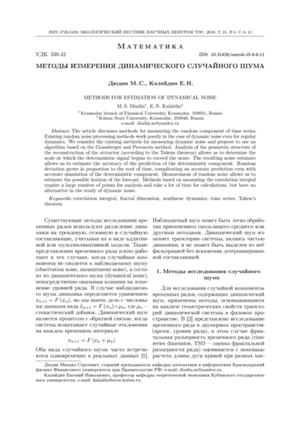Методы измерения динамического случайного шума
УДК
330.42EDN
YRMLCPDOI:
10.31429/vestnik-15-4-6-11Аннотация
Рассмотрены методы измерения случайной компоненты временного ряда для различных видов случайного шума. Анализ динамического шума основан на исследовании топологииаттрактора динамической системы. Представлен метод, заключающийся в измерении случайной компоненты ряда при помощианализа линейной части зависимости корреляционного интеграла ε в логарифмическом масштабе.
Ключевые слова:
корреляционный интеграл, фрактальная размерность, нелинейная динамика, временные ряды, теорема ТакенсаБиблиографические ссылки
- Kantz H., Schreiber T. Nonlinear time series analysis. Cambridge University Press, Cambridge, MA, 1997. 174 p.
- Sase T. et al. Estimating the level of dynamical noise in time series by using fractal dimensions // Physics Letters A. 2016. Т. 380. № 11. С. 1151–1163. DOI: 10.1016/j.physleta.2016.01.014
- Grassberger P., Procaccia I. Measuring the strangeness of strange attractors // Physica D: Nonlinear Phenomena. 1983. Т. 9. № 1–2. С. 189–208. DOI: 1016/0167-2789(83)90298-1
- Yu D. et al. Efficient implementation of the Gaussian kernel algorithm in estimating invariants and noise level from noisy time series data // Physical Review E. 2000. Т. 61. № 4. С. 3750. DOI: 10.1103/PhysRevE.61.3750
- Urbanowicz K., Hołyst J.A. Noise-level estimation of time series using coarse-grained entropy // Physical Review E. 2003. Т. 67. № 4. С. 046218. DOI: 10.1103/PhysRevE.67.046218
- Яновский Л.П., Филатов Д.А. Анализ состояния финансовых рынков на основе методов нелинейной динамики // Финансы и кредит. 2005. № 32 (200). С. 2–13. [Yanovskij L.P., Filatov D.A. Analiz sostoyaniya finansovykh rynkov na osnove metodov nelineynoy dinamiki [Analysis of financial markets based on non-linear dynamic methods]. Financy i kredit [Finance and credit], 2005, no. 32 (200). pp. 2–13. (In Russian)]
- Калайдин Е.Н., Дюдин М.С. Оценка риска в рамках гипотезы фрактального рынка // Финансы и кредит. 2013. № 22 (550). С. 31–34. [Kalaidin E.N., Diudin M.S. Otsenka riska v ramkakh gipotezy fraktal'nogo rynka [Risk assessment in the framework of the fractal market hypothesis]. Finansy i kredit [Finance and credit], 2013, no. 22 (550), pp. 31–34. (In Russian)]
- Калайдин Е.Н., Дюдин М.С. Измерение стохастической составляющей в динамике активов российского рынка капитала // Экономика устойчивого развития. 2012. № 11. С. 126–132. [Kalaidin E.N., Diudin M.S. Izmerenie stokhasticheskoy sostavlyayushchey v dinamike aktivov rossiyskogo rynka kapitala [Measurement of the stochastic component in the dynamics of the assets of the Russian capital market]. Ekonomika ustojchivogo razvitiya [Economics of Sustainable Development], 2012, no. 11, pp. 126–132. (In Russian)]
Скачивания

Даты
Поступила в редакцию
Принята к публикации
Публикация
Как цитировать
Лицензия
Copyright (c) 2018 Дюдин М.С., Калайдин Е.Н.

Это произведение доступно по лицензии Creative Commons «Attribution» («Атрибуция») 4.0 Всемирная.


